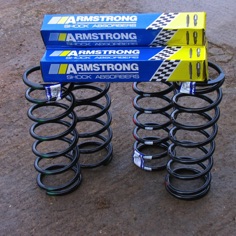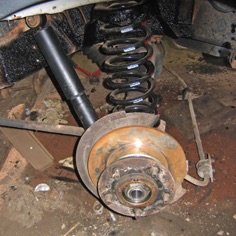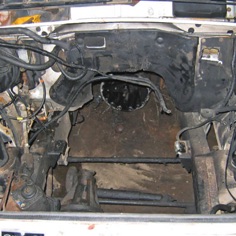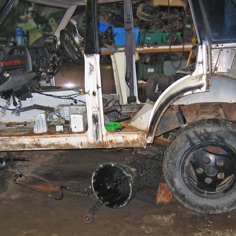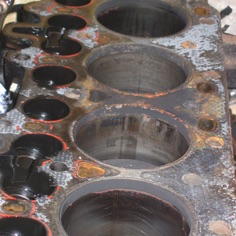If you have had anything to do with motor car rebuilds — restoration, race or apparently straightforward essential maintenance — you will know that taking the vehicle apart is the easy bit. That was exactly the case with our 1994 ex-Police Range Rover.
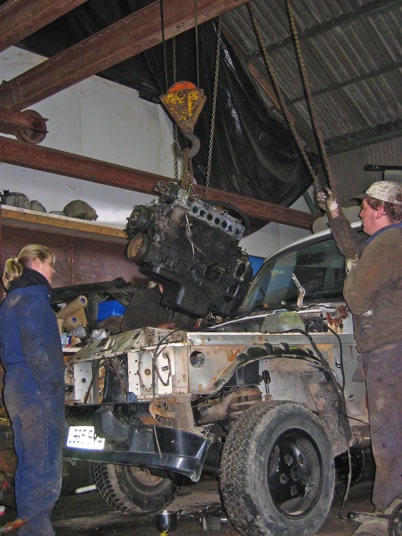
After a comparatively easy strip down, the size of the Range Rover recycling tasks ahead emphasise some grimmer realities in this episode
CLASSIC RANGE ROVER RECYCLED – Part 2
MOTOR WORKS AND THE WAITING GAME BEGINS
It came apart particularly quickly by conventional motorcar standards because so many aluminium panels are actually cladding to the hull/monocoque steel chassis. FBB Landrovers proprietor Rob White reckoned, “we can actually take a Range Rover apart in a day, but in your case the work was not done in one straight run, so it was spread over four days”.
Three visits in November 2006 saw Rob and up to three helpers, Dave Hide and two apprentices, one of them a hardy teenage female, wheedling the project Range apart. The sandy bonnet was first off, followed swiftly by the doors and tailgates, interspersed by the off white external body panels, front wings first. The original roof was retained for later swap to feature an electric sunroof.
None of the white outside panels would be used in the reborn machine, a K-registered grey donor Vogue SE offering a clean set of replacements — including that power-sliding roof — for all but one door. As seasoned Range owners will anticipate, we did not get lucky with the upper tailgate and tried several before the best of a poor bunch was adopted to replace the original. Our previous TDi also had an upper tailgate replaced and both upper and lower back panels were a problem on this recycling project, along with the front and rear bumpers. Factually, we never got upper tailgate and bumpers to the standard where you could say they were to secondhand car showroom standards of appearance.
The interior was simply all stripped out in respect of seats, carpets, underlay and trim. However, the dash panel, steering wheel and instruments all remained in place and were used in their ex-factory format. The same applied to the power steering, which showed no evidence of leaks. That proved a sensible decision.
December 2006 became particularly frustrating. There was no concrete progress on obtaining an underseal kit — Dinitrol or Waxoyl at this stage — and I had hoped to steam clean and thoroughly rust treat the bare chassis. A steam cleaner machine failure left a long, and not so thorough, manual process with plenty of wire brush finishing and pink Coma-branded sections.
Since rust had destroyed our previous Range Rover, you could say we as customers were uneasy about any compromises on this front, but Rob reassured us that they had not encountered any unexpected corrosion, corrective welding and plating only required in four areas: scuttle area in two afflicted sections between screen and motor bulkhead; plus two sections of the floor.
As an optimistic diversion, a series of shiny new parts were ordered and quickly arrived via Britpart. That covered clutch, Armstrong shock absorbers and a set of 10 per cent uprated coil springs. Original specification disc brakes also arrived; the original callipers and fresh pads clamped them. Looking through the pictures, I can see that, like the suspension components, the new discs sat on the project Range Rover for a very long time. So long that they had to be cleansed of surface rust periodically!
The bare motor and its key ancillaries, plus 4x4 transmission had to come out for treatment or replacement. The massive chains from the 2 ton-rated gantries embraced the disconnected motor for a straightforward, but nonetheless impressive, lift out of the engine bay.
Yet the gearbox was a pretty bloody 45-minute job. Basically Rob did this as an unbolt, loosen and trolley jack swivel ride to take the released weight. It absolutely was not that simple, requiring a tricky balancing act in a confined under-vehicle space. Rob’s sheer strength saw the job through and stopped the unit simply smashing onto concrete beneath. Not a pretty sight, and not a method I would recommend for first timers.
The original gearbox and clutch were not used in the reborn Rover. At this stage of the project, FBB had a good stock of Range Rovers and Discoveries to act as donors on hand at the site where our example was recycled. They still have an enormous supply of spares and Land Rover products to cannibalise, but the Larkhill site on the edge of Salisbury Plains, where the strip down and part of the rebuild were completed, was vacated at a critical stage in our project. That change of premises caused considerable delays as all the parts stock and inert vehicle for spares had to be moved on, mostly squeezing into one of FBB’s other two premises.
A disabled Discovery with a blown head gasket offered us the chance to take its 5-speed and later R380 gearbox for the rebuild. Later we discovered some bills that revealed we had been exceptionally lucky, for the box had covered less than 10,000 miles since overhaul. It proved the slickest I have operated on a Classic Range Rover, fresh press vehicles included.
The motor was transported to Barry Bawthorpe at East Clyffe, where a Wiltshire farm light industrial unit and extra parking awaited. FBB now utilise this site for far more work than when the project began. It was a treasure trove of rarities for sale and parts-breakers. These including a gold Wood & Picket special edition Range Rover that subsequently sold on eBay.
From a customer viewpoint these were the best premises FBB use, dry and with excellent access from a nearby main road, but there were more delays associated with this move. During 2007 FBB had to vacate their Larkhill premises, where the stripdown and earlier rebuilding of our project was in progress. So, East Clyffe was home for L865 SMA for the remaining 2007-08 later stages of its rebirth.
A partial motor reconditioning, complete with later service uprates, was planned. More about that later, as the engine was away for over six months and would not be reunited with our project vehicle until August 2007. I should make it clear that was NOT Barry’s fault as he was overloaded with extra and unrelated FBB work in this period.
In January 2007, the white and red stripe with sandy shades of L865 SMA components remained dismantled. The hulk hung from huge overhead chains like an oversize piece of butcher’s prime carcase. Rob prophetically observed, ‘ I reckon taking it apart is about a third of the job…it’ll take three times as long to put it back together again, that’s for sure!”
The engine work proved Rob’s prediction. The work itself was predictable. A cylinder head overhaul (sub-contracted to Lark Engineering at Amesbury and complete by February 2007) with a surface skim to guard against any warping in association with a new head gasket. Fresh gaskets were applied throughout, including the sump to block. New piston rings were fitted and connecting rod bearing shells were installed as a routine precaution.
The cylinder bores showed minimal wear, so no further block work was needed. Barry quipped that these blocks are so heavy and tough that “you can’t tell by the bores if it’s done 120,000 or 220,000 miles!” Barry also noted the helpful tip that the oil pump is integrated in the front cover and casing on 200 TDi where 200 TDi had a separated pump. We also received the timing belt update that was designed to overcome a known service problem and were the subject of a factory retro-fit programme. The result was a 300 TDi of great driving quality.
Unfortunately, for all concerned, the motor saga will have a return role in our final episode…

